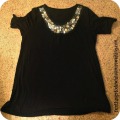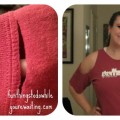T-shirts, amirite? I don’t know about you guys, but I have two drawers full of them. Not only do I collect cool t-shirts, but (like everyone else), I ALSO inadvertently acquire free, scratchy ones. Some of those get used as practice-runs for t-shirt mods, some get thrown into crafting ventures, others wind up in the rag bin. I still (at all times) have two drawers full of t-shirts. In these drawers, there are t-shirts that get worn more than others. There is always that group of tees, sitting at the bottom of drawer that get looked over in favor of their softer, or better fitting, brethren.
For those who have spent some time navigating the backwaters of Pinterest, you have no doubt come across a pin that looks something like this:
 Although I’ve seen this same black t-shirt with many different title fonts over the years, the recipe and “HoO” tag stay the same. After doing a little digging, and in the spirit of giving credit where it is due, I finally located the original image on the super-fun apparel website of octaneshop.com in an article titled: Brine Your Tee.
Although I’ve seen this same black t-shirt with many different title fonts over the years, the recipe and “HoO” tag stay the same. After doing a little digging, and in the spirit of giving credit where it is due, I finally located the original image on the super-fun apparel website of octaneshop.com in an article titled: Brine Your Tee.
We are big fans of brining on this site (and lordknows my favorite food gurus Cook’s Illustrated/America’s Test Kitchen love brining) we just didn’t realize its awesomeness also applied to non-edibles. As I had a stack of tees ripe for a-moddin’, I thought I would try out the ULTIMATE t-shirt mod (changing the texture of the fabric itself) first! As I was concerned about the salt eating the t-shirt art, I only used shirts that I wouldn’t have been devastated to lose. I’m not going to bore you with pictures of me, a bucket, three days, and some salt water, but that is what happened for those of you who like to use your imagination. I tripled the ratio, with a little extra water to cover the tees and a little less salt because I ran out. 🙂 Once a day, I went in to our guest bathroom/Pinterest Laboratory to stir the t-shirts in the brine. After three days, I drained the shirts and threw them in the wash.
Yes, Virginia. It totally worked. Not only were the tees super soft, but the salt did nothing (visible, at least) to the t-shirt paint/art. One of the tees was more bulky than the others, and I was worried it would matter. It didn’t. Although I wasn’t thrilled with disposing of three quarts of salty water or using copious amounts of our box of Kosher salt, the experiment totally worked. Unless you live at the ocean or have great quantities of salty water available to you, I would suggest perhaps saving up your shirts to do this in batches.
What do you think? Do you have t-shirts you avoid wearing in favor of softer ones? Do you also love The Best Recipe Cookbook from America’s Test Kitchen/Cooks Illustrated? Are there any pins on Pinterest you are dying for us try? As always, let us know in the comments!





I found this article really helpful in understanding the topic, it’s written in a way that’s easy to grasp and the information provided is super useful!